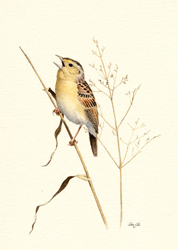Breeding Bird Atlases (BBA)
Find a Bird - BBA1
Breeding Bird Atlas 1 Species Accounts
Grasshopper Sparrow
Ammodramus savannarum
State Status
Threatened
Egg Dates
June 8 to June 26
Number of Broods
one

The Grasshopper Sparrow was described in Forbush (1929) as a “queer, sombre-colored, big-headed, short-tailed, unobtrusive little bird.” It is an uncommon breeding species in Massachusetts, near the northern edge of its range, and nests at scattered locations in the state. A bird of the coastal plain and river valleys, it is seldom found in Massachusetts above elevations of 1,000 feet. The state’s breeding population is believed to be declining due to loss of grassland habitat.
Formerly abundant on Nantucket and Martha’s Vineyard and in eastern Massachusetts, the species is now uncommon in these areas. Nashawena Island probably supports the state’s largest breeding concentration. Grassland areas adjacent to airfields continue to provide habitat used by Grasshopper Sparrows at several sites in the Connecticut River valley and elsewhere.
The Grasshopper Sparrow returns to Massachusetts in mid- to late May. It is a grassland bird, preferring dry sandy fields vegetated with bunch grasses and characterized by relatively low stem densities and a limited accumulation of ground litter. It is less likely to be found in fertile fields with lush, dense growths of sod-forming grasses and is generally absent from fields with greater than 35 percent cover in shrubs. Although management to maintain grassland habitat is essential to the conservation of Grasshopper Sparrows, mowing schedules must be manipulated to minimize disturbance to nesting birds during June.
Upon arrival on their nesting grounds, male Grasshopper Sparrows establish territories. Territorial songs are delivered from the highest perch available: a tall weed, small bush, or fence post. The bird’s name is derived from its grasshopperlike song—two short, low, introductory notes preceding a thin, dry buzz, tsick, tsick, tsurrrr. A more musical vocalization heard less frequently is a rolling trill.
Nesting takes place from late May through July. One brood per season is raised in Massachusetts. Nests are built on the ground and are well concealed at the base of clumps of grass or other vegetation. The nest is constructed of stems and blades of grass and is lined with fine grass and rootlets. The clutch size ranges from three to six eggs, with four and five as the most common numbers. A Worcester County nest contained five eggs on June 25 (DKW). Nests with eggs were found on June 8, June 11, and June 26 at Westover Air Force Base, Chicopee. Eggs are white and sparingly spotted or blotched with brown, gray, or purple. Incubation occurs at about 12 days. The female alone incubates the eggs and broods the young. The young remain in the nest approximately 9 days, after which they follow their parents around on the ground until they are capable of flight. Both adult and young Grasshopper Sparrows typically flutter low and erratically for a short distance and then drop back into the grass. At Fort Devens, Lancaster (a nest site discovered after the Atlas), adults carrying food for young were observed on June 13 and June 17 (TC).
Fall migration of adults and juveniles commences during late August and September and continues well into October; they are rare in winter in Massachusetts. Grasshopper Sparrows winter in the southern United States and south to Cuba, the Bahamas, Mexico, and Guatemala.
The Grasshopper Sparrow is listed as a threatened species in Massachusetts.
Map Legend and Data Summary
Atlas 1 data collected from 1975-1979


Note: very uncommon and local in grasslands of the Cape and Islands; rare elsewhere
Scott M. Melvin



